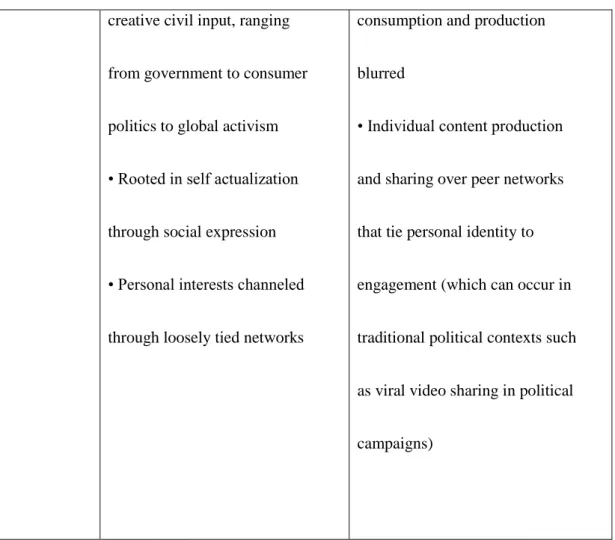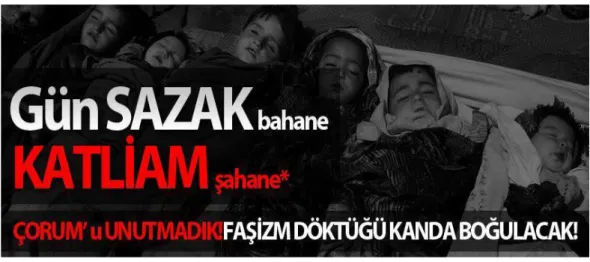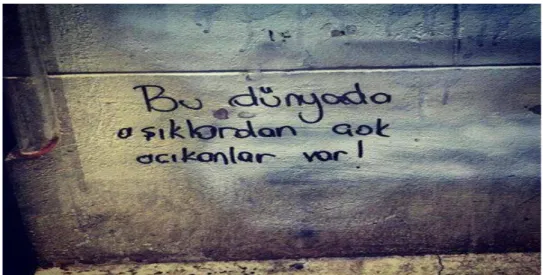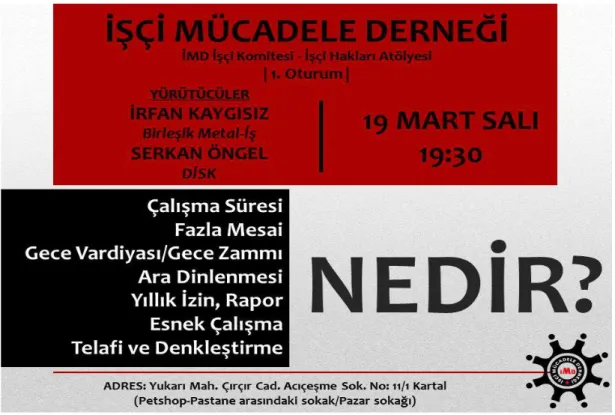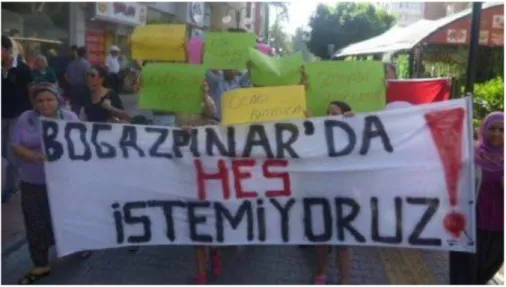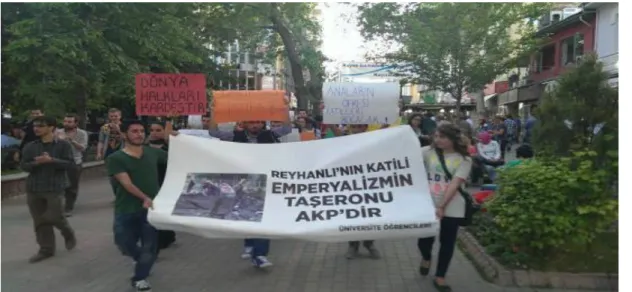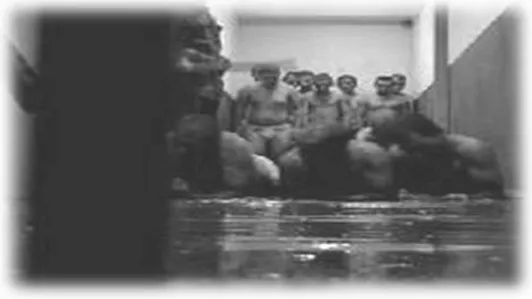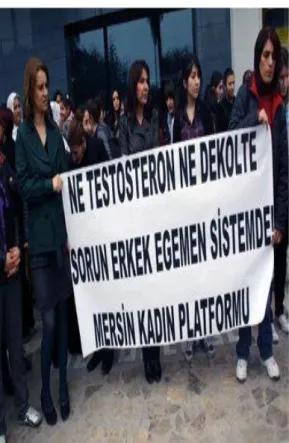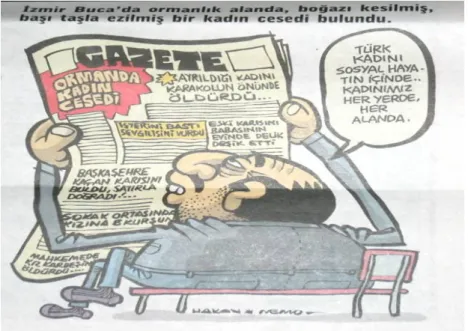ALTERNATIVE MEDIA AND DEMOCRACY: POLITICAL PARTICIPATION AND EXPRESSION THROUGH SOCIAL MEDIA IN TURKEY
A Master’s Thesis
by Oya ACET
Department of Communication and Design İhsan Doğramaci Bilkent University
Ankara August 2013
ALTERNATIVE MEDIA AND DEMOCRACY: POLITICAL PARTICIPATION AND EXPRESSION THROUGH SOCIAL MEDIA IN TURKEY
Graduate School of Economics and Social Sciences of
İhsan Doğramacı Bilkent University
by OYA ACET
In Partial Fulfilment of the Requirements for the Degree of MASTER OF ARTS
in
THE DEPARTMENT OF COMMUNICATION AND DESIGN İHSAN DOĞRAMACI BILKENT UNIVERSITY
ANKARA AUGUST 2013
I certify that I have read this thesis and in my opinion it is fully adequate, in scope and in quality a thesis for the degree of Master of Arts in Communication and Design.
___________________________ Assist.Prof.Dr. Özlem Savaş
Supervisor
I certify that I have read this thesis and in my opinion it is fully adequate, in scope and in quality a thesis for the degree of Master of Arts in Communication and Design.
___________________________ Assist. Prof. Dr. Ahmet Gürata
Examining Commitee Member
I certify that I have read this thesis and in my opinion it is fully adequate, in scope and in quality a thesis for the degree of Master of Arts in Communication and Design.
___________________________ Assist. Prof. Dr. Dilek Kaya
Examining Commitee Member
Approval of the Graduate School of Economics and Social Sciences
___________________________ Prof.Dr. Erdal Erel,
iii
ABSTRACT
ALTERNATIVE MEDIA AND DEMOCRACY: POLITICAL PARTICIPATION AND EXPRESSION THROUGH SOCIAL MEDIA IN TURKEY
Acet, Oya
M.A., Department of Communication and Design Supervisor: Assist. Prof. Dr. Özlem Savaş
August 2013
We live in a late-modern age characterized by globalization, self-reflexivity and high level of detraditionalization accompanied by the latest developments in the field of communication and information technologies. Besides its economic, social and cultural consequences, such an environment is mostly invested with great potential for realizing participatory democracy. Due to major transformations appeared in both class structure and cultural realm, the politics of late-modern age pursues a form of politics which is beyond left and right and, by a remarkable reformation, it can be called what Anthony Giddens calls a “third way politics”. Therefore, in such an environment, old political practices of participation and expression remain incompatible with social and cultural structure of the late-modern age. Herein, social media as a socialized and horizontal mode of communication, functions as a public space for struggles over power and counter-power especially for the groups who were interpellated as “others” since the foundation of the Turkish Republic in different periods of history. Benefiting from the discussions on the concepts of public sphere, citizenship, democracy and social media, this thesis studies the nature of political participation and expression through social media in Turkey and the potential of social media for being an instance of alternative media deepening democracy.
iv
ÖZET
ALTERNATİF MEDYA VE DEMOKRASİ: TÜRKİYE’DE SOSYAL MEDYA ARACILIĞIYLA SİYASİ KATILIM VE DIŞAVURUM
Acet, Oya
Yüksek Lisans, İletişim ve Tasarım Bölümü Tez Yöneticisi: Yrd. Doç. Dr. Özlem Savaş
Ağustos 2013
İletişim ve bilgi teknolojileri alanındaki son gelişmelerin, küreselleşmeye, özdüşünümselliğe ve yüksek düzeyde gelenekselleşmeden arınmaya eşlik ettiği geç modern dönemde yaşamaktayız. Ekonomik, sosyal ve kültürel sonuçlarının yanı sıra, bu ortam, çoğu zaman katılımcı demokrasinin gerçekleşmesi için büyük potansiyel barındırmaktadır. Sınıf yapısında ve kültürel alanda görülen önemli dönüşümler nedeniyle geç modern dönemdeki siyaset, sol/sağ siyasetinin ötesinde, Anthony Giddens tarafından “üçüncü yol siyaseti” olarak tanımlanan bir form izlemektedir. Böyle bir ortamda, eski siyasi katılım ve ifade pratikleri, geç modern dönemin sosyal ve kültürel yapısı ile bağdaşmamaktadır. Bu noktada, bir sosyal ve yatay iletişim formu olarak sosyal medya, özellikle Türkiye Cumhuriyeti’nin kuruluşundan beri tarihin farklı dönemlerinde “ötekiler” olarak çağrılan grupların iktidar ve karşı-iktidar üzerine mücadeleleri için bir kamusal alan işlevi görmektedir. Bu tez, kamusal alan, vatandaşlık, demokrasi ve sosyal medya kavramları üzerine yapılan tartışmalardan yararlanarak, Türkiye’de sosyal medya aracılığyla ortaya konan siyasi katılımın ve dışavurumun doğasını ve sosyal medyanın demokrasiyi derinleştiren bir alternatif medya olma potansiyelini incelemektedir.
Anahtar Kelimeler: Kamusal Alan, Demokrasi, Vatandaşlık, Sosyal Medya, Ötekilerin Postası
v
ACKNOWLEDGEMENTS
I would like to thank my family and my grandmother, especially my sister, for their endless support and belief in pursuing my academic interest and the path I tailor for myself.
I would also like to thank my advisor Assist. Prof. Dr. Özlem Savaş for her guidance, encouragement, emotional and academic support who, I believe, remarkably enhanced the quality of my thesis. Moreover, with their excellent criticisms and valuable comments, Assist. Prof. Dr. Dilek Kaya and Assist. Prof. Dr. Ahmet Gürata helped me to realize the potential that I have to be reflected in my future academic studies.
I would also like to thank Alper Özcan for always being there to support me, for his endless patience, for his moral support and for sharing my anxieties. Without his support, this thesis would have never been completed.
vi
TABLE OF CONTENTS
ABSTRACT ... iii ÖZET... iv ACKNOWLEDGEMENTS ... v TABLE OF CONTENTS ... vi LIST OF TABLES ... xi LIST OF FIGURES ... x CHAPTER 1: INTRODUCTION ... 1CHAPTER 2: FEATURES OF LATE-MODERN AGE ... 7
2.1. Culture of Modernity... 7
2.1.1. Modernity or Post-modernity? ... 9
2.2. Basic Characteristics of Late-Modern Period ... 12
2.3.Network Society ... 14
2.4.Changing Nature of Politics and Citizenship ... 15
2.4.1. Politics in Late-Modern Age ... 15
2.4.2.Third Way Political Programm ... 17
vii
2.5. Changing Trends in Citizenship ... 26
2.5.1. Cultural Citizenship ... 28
2.5.2. Radical Democratic Citizenship ... 31
2.5.3. Dutiful vs. Actualizing Citizenship... 32
CHAPTER 3: NEW MEDIA AND POLITICS ... 35
3.1. Definitions of New Media ... 35
3.2. Social Media and Social Network Sites ... 37
3.3. Media Convergence ... 41
3.4. The Internet, New Media and Their Political Implications... 42
3.4.1. Models of Public Spaces in Modern Period ... 42
3.4.1.1. Discursive Understanding of Public Space ... 45
3.5. Democracy and Public Sphere in Online Environments ... 51
3.6. The Role of Mass-Self Communication in Expression of Counter-Power ... 53
CHAPTER 4: ALTERNATIVE MEDIA AND DEMOCRACY ... 57
4.1. Alternative Media for Alternative Democracies ... 57
4.1.1. Radical Democracy ... 59
4.1.2. Dialogic Democracy ... 63
4.2 A Multi-theoretical Approach to Alternative Media ... 66
4.2.1. Alternative Media Serving to Community ... 71
4.2.2. Alternative Media as an Alternative to Mainstream Media ... 77
viii
4.2.4.Alternative Media as Rhizome ... 83
4.3. Political Participation and Expression thorugh Social Media ... 86
4.4. Significant Components of Turkish Political History ... 90
4.4.1. Turkish Modernization Process ... 90
4.4.2. Political Culture, the Structure of Civil Society and Public Sphere in Turkey ... 94
CHAPTER 5: SOCIAL MEDIA AND TURKEY ... 102
5.1 Turkey’s Social Media Profile and Facebook as a Social Network Site... 102
5.2. A Radical Instance of Democracy Alternative Media in Turkey: Ötekilerin Postası ... 104
5.2.1. The Call for Citizen Journalism ... 109
5.2.2. Ötekilerin Postası and Facebook as “Fascistbook” ... 110
5.2.3. General Rules of Ötekilerinn Postası ... 115
5.3. Various Topic Covered by Ötekilerin Postası ... 116
5.4 The Discussion ... 181
5.4.1.Facebook as a Form of Virtual Public Sphere ... 181
5.4.2. Analysis of Ötekilerin Postası through a Multi-theoretical Approach ... 197
5.4.2.1. Ötekilerin Postası Serving the Community... 198
5.4.2.2. Ötekilerin Postası as an Alternative to Mainstream Media ... 201
5.4.2.3. Linking Ötekilerin Postası to Civil Society ... 204
ix
5.4.3. Ötekilerin Postası as an Instance of Alternative Media and Its Potential for Democracy ... 209 CHAPTER 6: CONCLUSION ... 216
x
LIST OF TABLES
Table 1- Fundamental principles of classical social democracy and neoliberalism .. 17
Table 2- Marshall’s model of citizenship ... 27
Table 3- Dutiful and actualizing styles of civic action and communication ... 33
Table 4- Basic characteristics of the public sphere ... 47
Table 5- Positioning of the four theoretical approaches ... 71
Table 6- Access and participation of the community... 76
xi
LIST OF FIGURES
Figure 1: Generalist and minimalist models of civil society... 82
Figure 2: Resistance is in our souls. Raise the struggle! ... 108
Figure3: The Call for Citizen Journalism... 110
Figure 4: “Would you be our voluntary correspondent?” ... 110
Figure 5: “Do not touch Ötekilerin Postası!” ... 112
Figure 6: “Ötekilerin Postası is your voice, Protect your voice!” ... 112
Figure 7: “We have 75 thousand followers!” ... 112
Figure 8: “Any apparatus similar to firewall, phorm, echelon, and censorship cannot block a reasonable and questioning person to reach information. Censorship is a futile effort in the contemporary times in which a SMS reaches to the far end of the world in two shakes of a lamb's tail.” ... 114
Figure 9: 1864 ... 116
Figure 10: “We did not forget Corum. Fascism will drown in the blood that it shed!" ... 117
Figure 11: Conscientious Objection ... 117
xii
Figure 13: “End injustice directed to research assistances!” ... 120
Figure 14: The poster of Workers’ Struggle Association regarding a workshop on work-related concepts and worker rights ... 121
Figure 15: “We do not want a hydroelectric power plant in Bogazpınar!” ... 123
Figure 16: “Kurds look so nice because their language has been prohibited and all their feelings have been massed in their eyes”... 126
Figure 17: The city of Hasankeyf... 128
Figure 18: “AKP is the murderer of Reyhanlı and the proxy of imperialism” ... 130
Figure 19: A scene from the bombing ... 131
Figure 20: A photograph from the book picturing a scene of the trial ... 132
Figure 21: A photograph from the book picturing practices of humiliation and psychological torture ... 132
Figure 22: “Unitary State + Unitary Nation + Unitary Flag+ Unitary Language= Fascism” ... 134
Figure 23: “The danger for women comes from their closests!”Figure 18: “AKP is the murderer of Reyhanlı and the proxy of imperialism” ... 136
Figure 24: “The problem lies in male-dominated system rather than testosterone hormone and wearing revealing clothes” ... 136
Figure 25: “Turkish women are in social life...Our women are in everywhere, in every field.” ... 137
xiii
Figure 26: “In the first eight months of 2010, 200 women are murdered.
The number of women killed in July is at least 36” ... 138
Figure 27: The stickers designed by Muslims Opposing Violence Against Women Initative to raise awareness about violence against women ... 139
Figure 28: “Against sexual, national class-based exploitation, let’s meet in streets” ... 140
Figure 29:” We own our body, life and decisions! We have your family!” ... 140
Figure 30: A banner revealing different words used to signify “woman” ... 141
Figure 31: “We are kissing at Kurtulus subway station” ... 143
Figure 32: “Protect your freedom!! Turkey is kissing!” ... 144
Figure 33: “Curse on your morality!” ... 145
Figure 34: “We are meeting for Comrade Chavez!” ... 147
Figure 35: A woman subjected to procedures similar to animal testing ... 149
Figure 36: A photograph taken from a animal rights protest ... 151
Figure 37: Children working in waste collection and removal ... 153
Figure 38: “This year, Nevruz is celebrated not under the shades of guns but peace.” ... 154
Figure 39: “Everything is for a dignified peace- Happy Newroz!” ... 155
xiv
Figure 41: Celebrations in Ulm, Germany ... 157
Figure 42: Ötekilerin Postası: “Happy Newroz!” ... 157
Figure 43: “Some people bow before the government, METU is standing!” ... 158
Figure 44: “The people making reminders of September 12: Do not afraid! All these are marginalism” ... 158
Figure 45: “Tear Gas: Official drink of students, teachers, workers, civil servants, laborers, retirees. “Consume with lemon””... 159
Figure 46: A photograph picturing police intervention ... 160
Figure 47: “Police is the lawmen. Police should always be respected
and obeyed.” ... 162
Figure 48: “Tayyip Erdoğan: Private security will be removed from universities and they will be replaced by police” ... 163
Figure 49: “Police Fest in 174 universities with 174 thousand tear gas cannons” .. 164
Figure 50: “Revolutionary lawyers are our honour.” ... 165
Figure 51: “Your friend was arrested. Who is next?” ... 165
Figure 52: “We are addicted to our freedom not to alcohol, we are against AKP not buttermilk.” ... 167
Figure 53: “He (The Prime Minister) does not want a generation who is sloshed. If so, we do not also want a generation addicted to possession,
xv
Figure 54: Uludere Report: “No responsible found” ... 169
Figure 55: “All states are murderers. We will not forget, we will not forgive” ... 170
Figure 56: Barter Bazaar- Anarchist Platform ... 171
Figure 57: “Put on your anger, stand up in May 1.” ... 172
Figure 58: “To the streets, in May 1!” ... 172
Figure 59: “For equal, free, scientific education in native language, to the streets in May 1 for lighting a spark.” ... 173
Figure 60: “We are in the streets in May 1. A Communist world with come will anarchy!” ... 173
Figure 61: “Your repression and bans will not work. We do not accept the prohibition on Taksim.” ... 174
Figure 62: “You are responsible for the demolishment of Emek! Cancel the licence!” ... 175
Figure 63: “Do you have extra socks?”... 176
Figure 64: Aid campaign for Syria, “Today is the day we share our food.” ... 177
Figure 65: “I want justice for my daughter.” ... 179
Figure 66: “We want real justice.”, “You will never walk alone” ... 179
Figure 67: A photograph taken from a protest for gay marriage ... 181
xvi
Figure 69: A photograph revealing the existence of Muslim LGBT people... 181
Figure 70: “Stop the murders of transsexuals” ... 182
Figure 71, 72 and 73: Designs and graffities produced during Gezi Park protests .. 188
Figure 74: “It stinks freedom to high heaven” ... 189
Figure 75, 76, 77 and 78: Designs and graffiti produced during Gezi Park protests (Continuing) ... 190
Figure 79: “Same news, two different agency” ... 191
Figure 80: The advertisement published in New York Times on June 4 2013 ... 193
Figure 81, 82 and 83: Devrim (Revolution) Market and Gezi Park Library... 194
1
CHAPTER 1
INTRODUCTION
Political conservations are building blocks of public sphere, and the public sphere is in turn central to discussions on democracy. Although, generally, political discussions that people engage in public sphere have been associated with rational-critical debate and formal politics in line with the modern understanding, in late-modernity, new forms of political participation and expression have come into existence as a result of major transformations in the political structure, new conceptions of citizenship and democracy; and developments in information and communication technologies. Although political actions such as voting or rally attendance are certainly significant to formal democracy, people, in late-modernity, prefer different forms of political engagement. In this context, public sphere has been freed from its institutional context and expanded more to field of communication, and therefore, it is relatively easy to point out the changing nature of political participation and expression through analysing online environments. For this purpose, social media, particularly Facebook, as nearly the most widespread communication channel in cyberspace will be utilized as a means to both picture the nature of new public sphere and structure of political participation and expression.
2
Moreover, the potential of social media in voicing problems, concerns and demands of excluded and sub-altern groups as a form of alternative media, and encouraging and deepening democracy in Turkey will be among the issues covered in this thesis. In turning its full attention to political conversations and sharings on social media, this study aims to understand the potential of social media in functioning as a form of alternative media democratizing democracy.
Research Questions
This study seeks to answer these questions: What are the practices political participation and expression through social media in Turkey? Specifically, how do the people otherised and excluded by dominant discourses in Turkey express and represent themselves through social media? Can social media be considered as an alternative media, which encourage and deepen democracy?
Methodology
The analysis of online environments has necessitated a transformation in the structure of social research. The qualitative online research applied in this study uses the technologies and facilities of Internet by integrating traditional qualitative research methods to the Internet landscape. It is evident that computer-mediated communication requires a different methodological orientation for the researcher. Online qualitative inquiry gained momentum since the late 1990s defined by “breaks from the past, a focus on previously silenced voices, a turn to performance texts, and a concern with moral discourse, with critical conversations about democracy, race, gender, class, nation, freedom and community” (Lincoln and Denzin 2000: 1048). Working on a relatively a fluid and dynamic field of research, online researchers as bricoleurs, are continually inventing or piecing together new research tools, fitting
3
old methods to new problems (Mann and Stewart 2000: 5). Online researchers face with the challenge of inventing reliable and valid methods for studying issues and problems reflected in computer-mediated communication. Further, as Denzin (2004:2) notes, “online bricoleurs fit their methods to concrete problems, and the questions they are asking. The choices of which interpretive practices to apply cannot be set in advance…The online bricoleur is theoretically sophisticated, able to move back and forth through multiple theoretical spaces, from feminism, to critical and queer theory, to Marxism and cultural studies”.
Under such conditions, in this thesis, I follow a case study of a critical discourse analysis approach in handling Ötekilerin Postası (Others’s Post) functioning as an alternative media in Facebook presenting the structure of political participation and expression through social media in Turkey. Since case studies of online contexts, like case studies of offline environments, help to investigate particular interests in depth, the research subject has been analysed by this method. Moreover, political conversations and sharings are studied in terms of the relations between discourse and social, cultural and political developments in Turkey. Although critical discourse analysis is a method applied mostly in traditional social science research, I utilize this method as an effective and reliable means for online research since a great portion of the methods invented for online settings such as computer-mediated critical discourse analysis embodies a language-focused approach (Danet et al. 1997, Cherney 1999, Herring 1999a) underlining lexical choice and online word-formation process and preferring languge-focused content analysis. Therefore, online political participation and expression of users overwhelmingly occuring by means of discources is studied by the critical discourse analysis approach. Although there exist different approaches to critical discourse analysis, I will mainly reflect on
4
Fairclough’s overview. To begin with, the objective of critical discourse analysis is to explain the linguistic-discursive dimension of social and cultural processes and changes in late-modern period. Since discourse also exists in visual images besides written and spoken language, visual images are treated as linguistic texts and interpreted accordingly. Further, discourse refers to a form of social practice constructing the social world and in turn is constructed by it, and therefore, it forms a dialectical relationship with different social dimensions. However, “The discursive constitution of society does not emanate from a free play of ideals in people’s heads but from a social practice which is firmly rooted in and oriented to real, material social structures” (Fairclough 1992b:66). Critical discourse analysis also prefers to an empirical analysis of language use within a social context. Moreover, discources are the means for ideology and they function to create and sustain unequl relations of power. For Fairclough (1993:135), critical discourse analysis examine,
Often opaque relationships of causality and determination between (a) discursive practices, events and texts and (b) broader social and cultural structures, relations and processes […] how such practices, events and texts arise out of and are ideologically shaped by the relations of power and struggles over power […] how the opacity of these relationships between discourse and society is itself a factor securing power and hegemony.
Critical discourse analysis see inevitable nature role of discursive practices in social world and it sees a potential for social change giving way to a society governed by more equal power relations. Thus, with its commitment to social change, critical discourse analysis takes the side of the oppressed and excluded groups by the dominant discourse.
In line with the framework of analysis, the data required for critical discourse analysis were gathered through online non-participant observation between January 1st, 2013 and June 30th, 2013 among the political conversations and sharings
5
performed in the group page Ötekilerin Postası. Selection of materials was done according to their relations with recent developments seen in Turkish political, social and cultural life, the level of follower participation and the form of expressions of followers. In order not to intervene the structure of written language as a reflection of counter-discourse created by followers, the comments of followers and the notes of editors of the group were left as the way they were shared in the group. Translation of comments from Turkish to English was a quite challenging practice due to radicalized and high-inference language preferred by followers.
Outline
Chapter One provides an introduction, research questions and a brief summary of methodological approach utilized in the thesis.
Chapter Two is a quite comprehensive review of the characteristics of late-modern period and its reflections on new political understanding and new conceptions of citizenship.
Chapter Three describes the structure of new media, and transformative influence of social media and social network sites on political mobilization as a sign of counter-power in late-modern period. Furthermore, discussions on the emergence of a new form of public sphere and democracy are among the topics covered in this chapter.
Chapter Four focuses on the literature on alternative media and its relations to alternative democracies. Moreover, the practices of political participation and expression through are elaborated. The significant elements of Turkish political history are also provided which are necessary for critical discourse analysis.
6
Chapter Five handles Ötekilerin Postası as a radical example of an alternative media in Facebook and describes the topics covered by the group. In the discussion part, the qualitative inquiry questions the structure of Facebook as a virtual public sphere, Ötekilerin Postası as an alternative media and its potential for deepening of democracy.
7
CHAPTER 2
FEATURES OF LATE-MODERN AGE
2.1. Culture of Modernity
Modernity is generally described as the particular way of life and the state of mind of the ones who are experiencing the modern period. It signifies the experience of the economic, social, political, cultural, aesthetic and intellectual life “that implies the progressive economic and administrative rationalization and differentiation of the social world (Weber, Tönnies, Simmel); processes which brought into being the modern capitalist-industrial state” (Featherson 1998: 197-198). Moreover, modernity mostly refers to a period symbolised by the shift from feudalism to capitalism, industrialization, secularization, urbanization and rationalization. Rise of the nation state, and its powerful and well established institutions and particular forms of surveillance are also the distinctive characteristics of modernity. According to Stuart Hall, modern societies can be regarded as “social formations”, namely “societies with a definite structure and a well-defined set of social relations” (Hall, 1992: 7).
Giddens (1990:16) named as “high priest of modernity” by Mestrovic (1998: 2) defines the major characteristics of modernity as the separation of time and space,
8
disembedding of social systems and reflexive ordering and reordering of social relations. Therefore, major institutions, social relations, social structures and process of self-formation should be analysed in accordance with the features of modernity.
Many great classical sociologists (Marx, Durkheim and Weber) look from different aspects in interpreting the nature of modernity. Marx, to begin with, refers to capitalism and capitalist mode of production as the major transformative force in the modern world. He claims that new order of modernity pursues a capitalistic logic in both economic relations and its related institutions. Followingly, the nature of social, cultural and political realms are also inevitably and profoundly transformed in order to keep up with continuous development and increasing accumulation. Moreover, Weber argues that the core process of modernity is mainly shaped by rationalization giving way to a less magical and disenchanted world in which as tradition is disregarded, science becomes the major authority for knowledge and truth. Weber states that rationalization involves the rise of abstract and principled reasoning, secularization, universalistic claims of instrumental rationality, high level of differentiation in various fields and disciplines such as art and science and lifeworlds, and increasing specialization. As another approach, contrary to Marx, Durkheim traces the nature of modern institutions mainly to emergence and influence of industrialism. The constant change inhering in modern life results from not capitalism but “a complex division of labour and harnessing production to human needs through the industrial exploitation of nature”. Therefore, for Durkheim, whole modern social structure and its institutions formed by mechanical solidarity are based on high level of differentiation and division of labour, specialization, heterogeneity, low rigidity and intensity, and most importantly moral individualism rather than religion.
9
As can be seen in this sketch, modernity comes into existence as a result of major transformations in the mode of production, social structure and self- formation. However, it is clear that contemporary social, political, cultural and economic structures are highly distinct from the principles of the aforementioned classical modern world and the crises, in any kind, experienced today cannot be analysed in light of those theoretical perspectives. Herein, there arises the discussion on whether or not we live in a different world order, namely postmodernity completely detached from modernity.
2.1.1. Modernity or Postmodernity?
Although it is possible to identify different periods within modernity itself as early modernity, classical modernity and late modernity, recent social changes have brought about hot debates over the very nature of contemporary social world. These debates mainly revolve around the complex arguments about the nature of modernity and postmodernity. There are mainly two fractions explaining the conditions giving way to the emergence of postmodernity and its relationship to modernity. The first line of thought supports the view that we have not entered a new postmodern era that is completely and structurally different from the modern one. On the contraray, the contemporary period is only a moment in the history of modernity having quite different characteristics than the classical modern period. The transformations at issue are exemplified with the argument that in this period “traditional class politics and faith in progress are being replaced by ‘identity politics’ and ‘new’ social movements such as feminism, gay liberation, ecologism, ethnic revivalism, religious neofundamentalism” (Berg 1996:16). On the other hand, the remaining fraction suggests that although these changes have challenged the discourse and legitimacy of modernity. Moreover, the Enlightenment rationality loses it ground by new
10
postmodern knowledges claiming that reason functions as an illegitimate power to marginalize and exclude different forms of knowledge acquisition, which do not fit into its categories.
In the middle of such an argument, we can identify two distinct groups of theorists. The first party (i.e. Jürgen Habermas and Anthony Giddens) continues to believe that we live in a society still sharing the characteristics of modernity despite major structural transformations. On the other hand, thinkers like Jean Baudrillard, Jean François Lyotard, and Fredrick Jameson contend that society has undergone quiet dramatic changes and we live in a qualitatively different, postmodern era.
In order to analyse the nature of society today, it is better to define basic principles of postmodernity. Postmodernity cannot only be explained as a historical epoch succeeding modernity since it embodies a completely different world perspective. As Lyotard (1986) states “the grand old narratives of the modern social theory and philosophy have been rendered inoperative, they have lost their credibility”. Although postmodernists do not define their philosophy in a determined and clear-cut way, it is still possible to illustrate its basic principles.
For postmodernists, there is no absolute truth. The concept of truth is a contrived illusion used by the privileged in order to gain power to dominate others. Peace and progress cannot be achieved by conventional modern ways. Therefore, modern authority and the concept of authority in general as a source of rigid beliefs and principles should be opposed. Furthermore, trust on science and rationalization and quest for objectivity should be eliminated. Furthermore, since postmodernists suggest that morality is also relative, they think that each religion should be legitimate. In addition to not attributing any “core” or “center” for any social phenomenon,
11
postmodernists reject any meaningful continuity in history and search for unity. Moreover, postmodernists deconstruct the notion of a coherent self and replace it with a decentered and fragmented self, which is constantly in flux. In the postmodern thinking, the self is fashioned as a site for “performance” and “play”. As the final principle, postmodernists’ support regarding the equality for all regardless of class, religion, sex, ethnicity etc. reinforces their disbelief in the idea of nationalism and their desire for collective ownership.
Even though, at first glance, these principles seem to be quite emancipatory and subversive in nature, I think both the efforts of postmodernists in actualization of their utterances, and the nature and reality of contemporary world should be the points of discussion in identifying which party-modernists or postmodernists- provides a more comprehensive and appropriate picture of today’s society.
I will follow the theoretical perspectives of modernists such as Robert Bellah, Scott Lash, Richard Sennett, Ulrick Beck and John Urry in examining social, political and cultural landscape of contemporary late-modern society since I believe that we do not live in fragmented, unconnected lives devoid of a meaningful and essential center. Today, people still construct narratives about their identities even though such a process happens in a post-traditional order with post-traditional practices and the crisis of contemporary world lies at the very heart of this new order and emerging ways of expression, behavior and thinking in dealing with the problems. Therefore, I think, in line with the perspective of Anthony Giddens, the current social structure should be seen as a consequence of discontinuities within the modern period rather than a complete rupture. Therefore, through this inquiry, my main point of reference regarding the structure of contemporary world will be Gidden’s theory of late modernity.
12
2.2. Basic Characteristics of Late Modern Period
Giddens (1990, 1992) uses terms such as “radical”, “high” or “late” modernity to describe contemporary social structure and underlines few basic characteristics of this social order. High modernity is characterized by “widespread scepticism about providential reason, coupled with the recognition that since and technology are double-edged, creating new parameters of risk and danger as well as offering beneficent possibilities for humankind” (Giddens 1991:27).Giddens argues that early modernity included industrialism, use of material power and machinery in manufacture, a commodity production system and wage labour. Early modernity developed and reached its highest moment for pursuing interests of nation-state. However, late modernity differs essentially from the early one due to the type of modernization, which it inheres. In Reflexive Modernization (1994), written with Ulrick Beck and Scott Lash, Giddens further pictures his theory of late modernity. Late modernity is identified with reflexive modernization defined as the increasing capacity of self-conscious individuals and groups to apply knowledge to themselves and their societies critically.
Giddens states that late modernity has been shaped by mainly three developments. First, the influence of intensifying globalization alters the whole structure of society since “globalization does not only concern the creation of large-scale systems, but also the transformation of local, and even personal, contexts of social experience. Our day-to-day activities are increasingly influenced by the events happening on the other side of the world” (Giddens 1994:5). In such process, the role of instantaneous global communication shaping and restructuring everyday experiences and the self remain quite vital. Second, as almost a direct consequence of globalization, it is possible to identify the emergence of traditional social order. “A
post-13
traditional order is not one in which tradition disappears – far from it. It is one in which tradition changes its status. Traditions have to explain themselves, to become open to interrogation or discourse” (Giddens 1994:5). Although one of the main objectives of the Enlightenment was mostly to eradicate all forms of traditions, it only succeeded to destabilize their origins but traditions remained strong. Earlier forms of traditions have been restructured are formed in the name of nationalism, family, gender etc. which become a form of new traditions. However, in a globalizing, plural, heterogeneous and cosmopolitan society, traditions are challenged by,
A constant reasoning and questioning in a dialogic relationship. As the last feature, the expansion of social reflexivity remains as the third basic development transforming contemporary societies. “In a detraditionalizing society individuals must become used to filtering all sorts of information relevant to their life situations and routinely act on the basis of that filtering process...people demand more autonomy in their lives than ever before” (Giddens 1994:6).
The growth of social reflexivity gives way to some major changes in cultural, political and social spheres. Thus, in the field of politics, we witness a political reconstruction through which nation-states can no longer treat citizens as mere “subjects” since today citizens reveal their political behavior and involvement via different media and forms of expression reinforced by increased social reflexivity. Moreover, in the social sphere, people have been participating in open-ended social organizations to a large extent and due to the demise of final authorities, people have been to “fall back increasingly on their resources to construct a coherent identity for themselves” (Thompson, 1995:207). In late-modernity, self can be regarded as a symbolic project and with the expansion of globalization, detraditionalization and high level of social reflexivity, people try to create and maintain a coherent narrative of the self.
14 As Thompson states:
It is a project that the individual constructs out of the symbolic materials which are available to him or her, materials which the individual weaves into a coherent account of who he or she is, a narrative of self-identity...To recount to ourselves or others who we are is to retell the narratives-which are continuously modified in the process of retelling-of how we got to where we are and of where we are going form here (Thompson,1995:210).
In line with such a project, people have to make a series of choices not only on their tastes, preferences and lifestyles but also on their life destinations and relationships. Thus, individuals have to be constantly “self-reflexive” about their actions and decisions in order to maintain a consistent narrative of their ‘self’.
2.3.The Network Society
Agreeing on the basic principles of post-traditional or late-modern society pictured in Giddens’ theory, putting much emphasis on the information technology revolution and its radical and transformative effects, and the major transformations taking place towards the end of 20th century, Manuel Castells underlines the rise of a new form of a society as the ‘network society’ and defines the term as “the social structure that results from the interaction between social organization, social change, and a technological paradigm constituted around digital information and communication technologies” (Castells 2004: xvii). Underlying the significance of the information technology revolution, in his book The Rise of the Network Society Castells states that “as a historical trend, dominant functions and processes in the information age are increasingly organized around networks. Networks constitute the new social morphology of our societies, and the diffusion of networking logic substantially modifies the operation and outcomes in processes of production, experience, power and culture. While the networking form of social organization has existed in other times and spaces, the new information technology paradigm provide the material
15
basis for its pervasive expansion throughout the entire social structure” (Castells 1996:467).
With the emergence of network society, we have witnessed radical transformations on the level of community, production, communication, self-formation and politics. Replacing the mass society as a social formation based on large concentrations of people coming together in industrial towns and trading centres, the networks society acquires completely different structural characteristics. With the rise of information and communication technologies, computer-mediated communication and the Internet, mass societies composed of organic communities having direct relationships between individuals mainly on the basis of face-to-face communication in conditions of co-presence has been turned to virtual communities in which associations between people are not tied to particular space, time and other physical conditions.(Van Dijk,1999). Furthermore, besides these substantial changes, Castells touches upon the relation between the net and the self, and new modes of time and space experienced in network society. Both space and time have been transformed under the radical impact of information technology paradigm and they are now reconsidered as space of flows and timeless time (Castells, 1996). As the final point, the network society favours networked forms of social organization compared to the ones previously employed “vertical-hierarchical organizations” (Castell, 2004: 3).
2.4. Changing Nature of Politics and Citizenship in Late-Modern Age
2.4.1. Politics in Late-Modern Age
The political structure of late-modern age has been shaped by great historical and political changes happened in 20th century. The death of socialism and its values and ideals, changes in class structure, proliferation of identity-based politics,
16
globalization, development of information and communication technologies, changes in conceptions of time and space, encouragement of cultural diversity and emergence of new social movements etc. have required some major renewal of political programme which is more suitable to the characteristics of the late-modern period. Today, although we observe some versions of classical social democratic or leftist thinking, and demands for more democratic political systems, we no longer believe that what Marx wrote “ a spectre is haunting Europe” referring to the spectre of socialism and communism. In contemporary political atmosphere, even the most radical forms of political mobilization do not follow such a utopian motivation. Rather, since politics of late-modern age cannot take class politics as a main point of reference due to major transformations happened in 20th century, the demands of many social movements mainly revolve around the issue of rights to be given to the excluded and betterment in the scope of democratization especially within the context of identity politics. In other words, the core values embodied by left and right political leanings did lose their significance in today’s political structure. Therefore, politics of late-modern age pursues a type of politics, which is beyond left, and right and, by a remarkable reformation, it can be called what Giddens calls a “third way politics”. In this context, ‘third way’ is defined by Giddens (1999:26) as “a framework of thinking and policy-making that seeks to adapt social democracy to a world which has changed fundamentally over the past two or three decades. It is a third way in the sense that it is an attempt to transcend both old-style social democracy and neoliberalism”. Before presenting third way programme and its new political practices, it is necessary to highlight basic principles of its preceding political philosophies corresponding to the left and the right.
17 2.4.2. The Third Way Political Programme
Giddens, in his book the Third Way, provides a quite comprehensive outlook of two conflicting political leanings which, to a larger extent, are incompatible with current social and political environment. He pictures fundamental principles of classical social democracy and neoliberalism in order to unfold their inadequacies in responding the political, social, economical and cultural structure of late-modern period.
Classical Social Democracy
(The Old Left)
Thatcherism, or Neoliberalism
(The New Right)
Pervasive state involvement in social and economic life
State dominates over civil society
Collectivism
Keynesian demand management, plus corporatism
Confined role for markets: the mixed or social economy
Full employment Strong egalitarianism
Comprehensive welfare state, protecting citizens ‘from cradle to
Minimal government Autonomous civil society Market fundamentalism
Moral authoritarianism, plus strong economic individualism
Labour market clears like any other Acceptance of inequality
Traditional nationalism Welfare state as safety net Linear modernization
Low ecological consciousness Realist theory of international order
18
Table 1: Fundamental principles of classical social democracy and neoliberalism, (Giddens 1999:7-8)
Especially after the collapse of the East European communism in 1989, many social democratic parties did acknowledge the need for a major renewal in the programme of social democracy and left wing political philosophy that will be more compatible with trajectories of the period. Influenced by the emphasis of neoliberalism, new social democratic formation has more integrated the issues of individual freedom and personal choice into its agenda. As opposed to classical social democracy, new social democratic programme abandoned its strict plan in the field of production. Rather, although their intensity cannot be compared to appeal of specific interest groups, ecological consciousness has been introduced as a kind of social democratic policy. In Kitschelt’s (1994:33) words, social democracy “moved beyond the arena of resource distribution to address the physical and social organization of production and cultural conditions of consumption in advanced capitalist societies”.
In light of these changes in the philosophy of social democracy, since the mid-1980s, many leading European communist parties have converted both their philosophies and policies such that the issues coming into prominence such as ecological concerns, participatory politics and community development have resulted in
grave’
Linear modernization
Low ecological consciousness Internationalism
Belongs to bipolar world
19
corrosion to the conflict between left and right. In other words, the left/right division have failed to capture social reality of late-modern period.
Giddens unfolds the reasons of changes appeared in structures of political support giving way to renewal of social democratic programme. Giddens (1999:20) states that “the class relations that used to underlie voting and political affiliations have shifted dramatically, owing to the steep decline in the blue-collar working class.” Furthermore, he points out the value changes occurring due to mainly generational changes in addition to other influences. With regard to these changes, he utilizes Inglehart’s thesis of value change referring to a shift from ‘scarcity values’ to ‘post-materialist values’. Giddens (1999:21) indicates that “Inglehart shows values of economic achievement and economic growth do fade with increasing prosperity. Self-expression and the desire for meaningful work are replacing the maximizing of economic rewards. These concerns are related to a sceptical attitude towards authority- which can be depoliticizing, but on the whole pushes towards greater democracy and involvement than is currently available in conventional politics”. In such an atmosphere dominated by post-materialist values, politics cannot be the politics of a class bloc. Rather, since citizens do no longer participate in political system according to their place in class structure but their socially and culturally constructed identities, it is possible to claim that the intensity of identity-based politics tend to outweigh class-based politics in late-modern period.
Giddens introduces five dilemmas waiting for social democracy, namely globalization, individualism, the nature of the left and the right, political agency and ecological problems. To begin with, as Giddens (1999:31) states, “globalization is not only, or even primarily, about economic interdependence, but about the transformation of time and space in our lives”. Especially with the communications
20
revolution and the spread of information technology, today every decision, which a person, an institution, an organization and a government make, is a consequence of globalizing processes and is invested with global effects due to existence of interconnected power relations. The effects of globalization have given way to both the rise of ‘new individualism’ and new forms of collectivity and solidarity. The concept of ‘new individualism’ at issue here does not signify indifference, depoliticization and “me” generation. On the contrary, with communication revolution, today many people make themselves heard in the public sphere in line with their specific interests such as ecological problems and human rights. The most significant aspect of new individualism is that values are not depended on tradition. As Beck states (1998), people are called for constituting themselves as individuals who plan, understand, design their selves. Furthermore, new individualism voices the demands for greater democratization.
Regarding the nature of the left/right distinction, today, in line with the new social democratic framework, the distinction at issue here is in the process of re-establishment. Together with socialism and great scope of globalization, we can no longer picture strong oppositional left and right political philosophies. Since the concept of “enemy” disappeared, powerful organization around some fundamental values and principles has also lost significance. Today, the major answer to which all political approaches have tried to respond refers to the question that how capitalism should be governed and regulated in most effective way. The left and right parties have been redefined according to their responses to this particular question. Besides the problems regarding capitalism, late-modern political landscape has been occupied with the issues within the reach of the left/right scheme. These issues refers to ecological problems, changing nature of work, family, personal and cultural
21
identity which goes beyond values of the classical left such as social justice and emancipation. Therefore, late-modern politics has been governed by both, what Giddens calls, emancipatory politics of the classical left and life politics. In Giddens (1999:44) words, “whereas emancipatory politics concerns life chances, life politics concerns life decisions. It is a politics of choice, identity and mutuality”. Therefore, instead of the left/right division, Giddens offers the idea of ‘active middle’ or the ‘radical centre’ since the fractions of the left and the right are not sufficient to propose radical solutions and radical policies to the problems of life politics.
The renewal in the left/right framework has brought about the question of political agency. In late-modern era, politics regarded as inconclusive and government drained of power has to respond the demands of new social movements. As Giddens (1999:47) states that in contemporary world, government exists to “offer a forum for reconciling the comparing claims of diverse interests, create and open public sphere, in which unconstrained debate about policy issues can be carried on”. By the loss of power of national governments, new social movements can be regarded as new forms of political engagement and mobilization. In line with such a trend, Beck (1992) introduces the concept of ‘sub-politics’ referring to the politics that has migrated away from parliament towards single-issue groups in the society. Sub-politics is formed by active citizen involvement to mostly issues related to identity without seeing government’s policy implementations as an only and final solution to related problems. Herein, citizens find the power to demand, control and negotiate with government’s perspectives and implementations regarding a specific issue. Bearing in mind all these aspects, Giddens (1999:64) indicates that “the overall aim of third way politics should be to help citizens pilot their way through the major revolutions
22
of our time: globalization, transformations in personal life and our relationship to nature.”
The third way political programme also aims at a significant restructuring of the state and its relations to civil society in order to realizing the process of the deepening and widening of democracy and civic engagement. Collaboration between state and civil society bear a potential for a powerful civic culture. In line with such a reformation, emergence of an open and transparent public sphere as a space for participatory democracy stands as the indispensible principles of the new formation of state. Furthermore, in late-modern age, the concept of nation-state has to be subjected to restructuring due to high potential of fragmentation resulted from different and various identity positions and cultural diversity.
Regarding the issue of nationhood, Giddens (1999:130) proposes a more cosmopolitan version of nationhood since “the borders of current states are becoming frontiers because of their ties to other regions and their involvement with transnational groupings of all kinds”. Within the scope of third way politics, cultural diversity and multiculturalism as two significant social dynamics of contemporary late-modern age are planned to go hand in hand with the national identities. As Miller (1995:420) states, “we must hold on to the principle of nationality, while striving to forge national identities that can accommodate the pluralism and mutability of contemporary culture”. In line with this formulation, what is expected is to build open and inclusive and reflexive construction of national identity.
2.4.3. Radical Politics for Radicalized Modernity
Political radicalism is historically associated with the various fractions of the left political philosophies since it is invested with the demands of major and subversive
23
structural transformations in various spheres. The most remarkable example of such demands was resulted from socialism. However, today, the hope for socialism and communism has lost its credibility and therefore, political radicalism has been shaped by motivations quite different from ones of the old left and the right in line with the changing dynamics of society. New radicals have turned their eyes to new social movements organized around single-issues due to the fact that people have to define themselves on the basis of mostly socially constructed identities compared to class-based orientations. In line with this transformation, politics and social movements have shaped according to problems of identity rather than class. Thus, as Giddens (1994:3) affirms, “New social movements cannot readily be claimed for socialism. While the aspirations of some such movements stand close to socialist trends, their objectives are disparate and sometimes actively opposed to one another [...] .the new social movements are not ‘totalizing’ in the way socialism is (or was), promising a new ‘stage’ of social development beyond the existing order”.
Radicalized modernity characterized by globalization, post-traditional social order and social reflexivity have altered the role of nation-state, citizenship practices, political participation, political expression and mobilization. In other words, radicalized modernity, with all its institutions, has given way to a complete political reconstruction. In light of such a restructuring in politics, radicalized modernity can only be organized around the radical politics. In this social structure, old political philosophies fall short of responding the needs of society. As Giddens (1994) points out, while socialism and conservatism stands as disintegrated, neoliberalism is paradoxical and liberal democracy remains not quite well equipped to responding the demands of reflexive citizenry of the radicalized modernity.
24
Radical politics has several objectives to attain a comprehensive political reconstruction appropriate for characteristics of radicalized modernity. The first objective aims at repairing damaged solidarities. In Giddens (1994:13) words, “we should speak more of reordered conditions of individual and collective life, producing forms of social disintegration to be sure, but also offering new bases for generating solidarities”. In other words, the plan is to combine the concepts of new individualism and collectivity in a way that it opens a way for forming a new kind of solidarity different from the old ones. New form of solidarity should result from reconciliation of individual autonomy, reciprocity and interdependence. Moreover, solidarity in a post-traditional social order should follow the principle of active trust and renewal of personal and social responsibility for other reflected through various media.
The following objective refers to rising significance of life politics in addition to emancipatory politics. Throughout the history of the political left, the idea of emancipation has been the main motivation for various social movements. Emancipation means freedom exercised in different fields ranging from freedom from domination to tradition. While emancipatory politics deals with the issues related to life chances, since radicalized modernity is invested other problems mainly related to consumption, social status and identity, the political realm has been extended by integration of life politics as self-actualisation. In a period in which class politics, and accordingly, emancipatory politics have lost its intensity, life politics functions as the dominant mode of political form without breaking ties with its emancipatory ideals. In Giddens’ (1990:156) words, “An “ethics of the personal” is a grounding feature of life politics, just as the more established ideas of justice and equality are of emancipatory politics.”
25
As an another objective, radical politics supports emergence of generative politics appearing in an atmosphere in which state exercises its power only to a limited degree. Therefore, generative politics defined by Giddens (1999) as “a politics which seeks to allow individuals and groups to make things happen, rather than have things happen to them, in the context of overall social concerns and goals” have the potential to transcend hegemony of state power and make life-political decisions taken by reflexive citizenry.
The reflections of radical modernity and radical politics have been revealed through social movements as modes of radical engagements. According to Melucci (1989), social movements provide glimpses of possible futures and are in some part means for their realisation. Social movements mostly regarded as expressions of counter-power and dissatisfaction have taken many forms in radicalized modernity. Giddens (1990) introduces four types of social movements, namely free speech/democratic movements, labour movements, ecological movements and peace movements exercised through modernity. Today, although they share their main objectives with the old ones, new social movements have become more specialized and diverse in line with life politics as self-actualisation, the developments in information and communication technologies and globalization. As Şentürk (2006:41) defines, “new social movements differ from classical ones in terms of their unconnectedness to a political base, lack of a class-based and economical background, heterogeneous organization and education level of their members and their appeal to cultural field as a focus”. The emergence of contemporary modes of radical political expression, participation and mobilization cannot be handled without touching upon new citizenship practices.
26 2.5. Changing Trends in Citizenship
The information and communication technology revolution, emergence of new media, characteristics of late- modern age such as globalization and high level of self-reflexivity have foregrounded hot debates about the relationship between changing nature of citizenship, its practices and a new form of doing politics. Herein, the issues of democratization, escalating civic participation and involvement have also become quite pertinent to the transformations at issue.
Studies on citizenship mainly reached an agreement on three points. First, modern citizenship is defined as a personal status consisting of a body of universal rights (i.e., legal claims on the state) and duties held equally by all legal members of a nation state (Marshall 1964; Brubaker 1992). Second, most scholars share the view that the legal requirements of an emergent capitalist society were chiefly responsible for the birth of modern citizenship rights (Bendix 1977, Barbalet 1989). Third, most scholars offer that theories on citizenships should be arisen from the complex relationship between the state and the capitalist economy (Ofle 1984, Lindlom 1977).
The conceptualization of citizenship introduced should be exposed to a subversive rethinking in line with the developments and changes emerged in social, political and cultural fields in late-modern times. However, such a rethinking should begin with the classic work of T. H. Marshall (1964), Citizenship and Social Class, which remains as a main point of reference in citizenship studies. Marshall’s definition of modern citizenship includes formal rights, duties and social entitlements- “the whole range from the right to a modicum of economic welfare and security to the right to share to the full in the social heritage and to live the life of a civilized being according to the standards prevailing in the society” (Marshall 1964:72). With these
27
characteristics, modern citizenship embraces three kinds of rights, which can be assigned to different periods in history: civil rights such as right to sell one’s labour in a free market economy, political rights such as the right to vote and social rights such as the right to social justice through social security, unemployment insurance etc.
Period Rights Institutions
17-18th centuries Legal rights Jury system
18-19th centuries Political rights Parliaments
19-20th centuries Social rights Welfare State
Table 2: Marshall’s model of citizenship, (Turner 1997:12)
Even though Marshall’s theory of citizenship and the related history have been and still is a seminal understanding in the field, it is not devoid of major criticisms leading us to a necessity to a reformulation of citizenship responding the structure of contemporary society. To begin with, many scholars disagree with the Marshall’s model especially with its explanation regarding form of citizenship and its practices in 20th century. It is argued that 20th century has witnessed various forms of economic citizenship in the forms of workers’ participation, economic democracy or industrial democracy (Turner, 1997). Furthermore, Marshall’s model is highly criticized due to its lack of interest in development of cultural rights, linguistic, religious and cultural differentiation (Turner, 1997) and democratisation reflected in the principle of the ontological equality of human beings, individual autonomy and equality of opportunity (Mannheim, 1992). Moreover, as Turner (1997:14) points out, “Marshall took identity for granted, [...] Marshall’s theory does not provide any
28
guidance for understanding citizenship in a multicultural environment, where there are systematic contradictions of identity.”
These criticisms have resulted in formation of an alternative history of citizenship and a new paradigm for contemporary citizenship practices especially revolving around problems of identity. As Turner (1994) indicates, postmodernization of culture and the globalization of politics have rendered the existing citizenship literature insufficient and the development of transnational spheres of governance, instantaneous news and global networks paving the way for new social movements’ alteration the assumed organic relationship between citizenship and the nation state. In Mitchell’s (2003:387) words, “if the western citizen of the nineteenth century was a member of a consolidating nation, the contemporary citizen of the twenty-first century is a member of a deterritorializing state.” Thus, following the recent changing structural trends, Miller (2007:35) states that “the last two hundred years of modernity have produced three zones of citizenship, with partially overlapping but also distinct historicities. These zones of citizenship are: the political (the right to reside and vote), the economic (the right to work and prosper) and the cultural (the right to know and speak). The first category concerns political rights; the second, material interests; and the third, cultural representation (Rawls 1971:61).
2.5.1. Cultural Citizenship
The type, which corresponds to the third zone of citizenship and responds to contemporary social, political and cultural social structure is defined as cultural citizenship. The term is loaded with various conceptions from different academic fields and therefore defined accordingly. In other words, the idea of cultural citizenship is adrift referring multiculturalism and identity politics for some,
